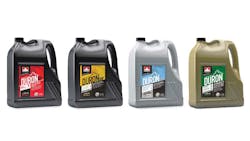DECEMBER brings the official introduction of a new heavy-duty diesel engine oil category. Formerly known as Proposed Category 11 (PC-11), the primary drivers behind its development have been the introduction of new, hotter running engine designs and a tightening of legislation—both on the emissions side and, for the first time, on fuel economy—for heavy-duty trucks.
The desire for fuel economy improvement has been motivated by both end user demand for lower operating costs and by greenhouse gas (GHG) emissions regulations, specifically those focused on CO2.
In 2011, the National Highway Traffic Safety Admini-stration (NHTSA) and US Environmental Protection Agency (EPA) finalized rules to establish a comprehensive Heavy-Duty National Program to reduce GHG emissions and fuel consumption for on-road heavy-duty vehicles.
NHTSA’s final fuel consumption standards and EPA’s final CO2 emissions standards are tailored to each of three regulatory categories of heavy-duty vehicles: combination tractors, heavy-duty pickup trucks and vans, and vocational vehicles.
Having been phased in since 2014, the combined standards are expected to reduce CO2 emissions by approximately 270 million metric tons and save 530 million barrels of oil over the life of vehicles sold in 2014 to 2018 model years.
To meet the requirements of these standards, Original Equipment Manufacturers (OEMs) introduced new engine designs, operating strategies, and began to look at the use of lower viscosity lubricants.
If we look back at the evolution of both engine design and operation from 2006 all the way up through 2017 model year, there have been a number of changes that have increased the stress and demand placed on lubricants.
Some of these changes have included increased compression ratios, elevated cylinder pressures, higher temperatures, down-speeding, thermal management, and several others.
In particular, modern diesel engines are running hotter than ever. This has increased the thermal and oxidative load on lubricants, and if not properly controlled, can lead to corrosive wear from organic acid formation, deposits in the piston ring zone, and viscosity increase that can negatively impact fuel economy.
As a result of these challenges, specific industry requests for PC-11 included improvements in oxidation control, shear stability, aeration control and thermal management.
Two subcategories
The Engine Manufacturers Association (EMA) requested that the new PC-11 category be split into two separate and distinct subcategories.
The first, API CK-4 oils, will exceed the performance of the current API CJ-4 oils, providing enhanced protection in current and future engine designs. They will also be backward serviceable meaning they can be used in both older and new diesel engines.
API FA-4 oils, on the other hand, could be called the “more robust API CJ-4 at lower viscosity” or even the new “fuel economy grades.” They are going to be some of the lowest viscosity heavy-duty diesel engine oils that have ever been used by the industry and will deliver greater fuel economy and lower greenhouse gas emissions by reducing the high temperature high shear (HTHS) viscosity limit relative to CK-4 oils.
PC-11 adoption
As OEMs have started sharing their oil recommendations for 2017 model year engines, many will primarily recommend API CK-4 oils which will also need to meet their own OEM specifications.
Less clear is the adoption of the new API FA-4 lower viscosity oils for fuel economy. Some OEMs may allow the use of FA-4 oils or recommend its use in some fuel economy focused applications. API user guidance states that FA-4 oils are not backwards compatible which may slow the adoption rate for service fill applications. While some OEMs may allow limited back serviceability to encourage their use, most industry observers expect API CK-4 to be the product of choice for many years to come.
The fastest growing product is expected to be SAE 10W-30 API CK-4, which provides improved fuel economy over SAE 15W-40, while being recommended for both new and old engines. As fleets bring in new engines they will eventually adopt the newer SAE 10W-30 API FA-4 product, when recommended by OEMs, which will provide even larger fuel economy benefits.
Now that the category is well defined one big challenge for our industry is customer and end user communication. The industry as a whole will need to explain the differences between these oils and the current oils in the market, and what value those differences bring in terms of engine protection. ♦
About the Author:
Steve Haffner is North American Market Manager for Infineum, a leading formulator and manufacturer of fuel and lubricant additives.
Helpful web sites
Try these web sites to find out the latest on the new CK-4 and FA-4 heavy-duty diesel engine oil categories:
Infineum: www.infineuminsight.com/pc-11
Petro-Canada Lubricants: www.DURONthetougherthebetter.com
Shell Lubricants: www.WhatIsCK4.com and www.WhatIsFA4.com
